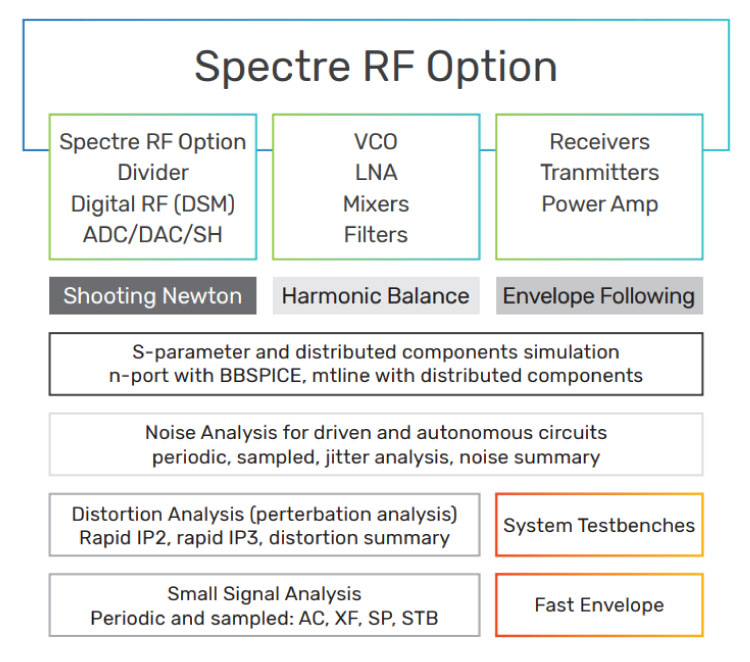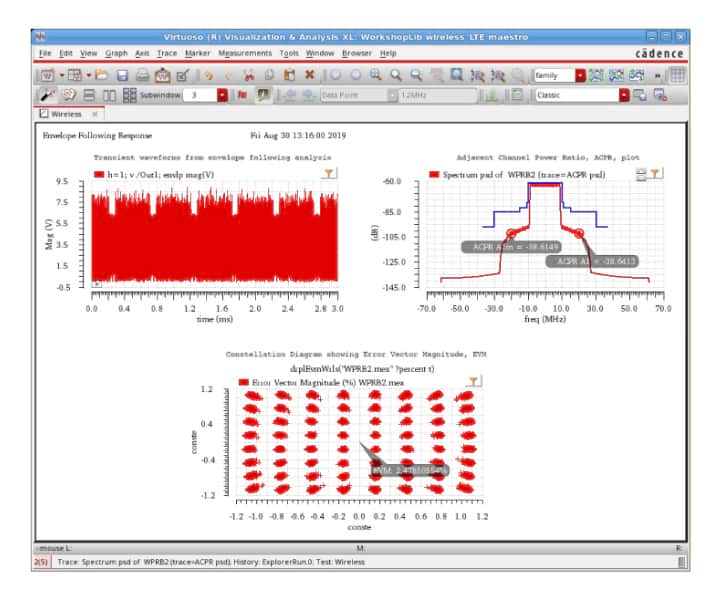Datasheet
Spectre RF Option
Accurate and fast simulation for RFIC circuits
The Cadence Spectre RF Option, an option to both the Spectre X Simulator and the Spectre Accelerated Parallel Simulator (APS), provides a set of comprehensive RF analyses. The Spectre RF Option includes two production-proven simulation engines: a harmonic balance, frequency-domain solver and a shooting Newton, time-domain solver. The Spectre RF Option supports the same models as the Spectre Simulation Platform. The Spectre RF Option works with the Cadence Virtuoso RF Solution to provide a comprehensive solution for design of RF and microwave circuits and modules.
Overview
Spectre Simulation Platform
As the industry’s leading solution for accurate analog simulation, the Spectre Simulation Platform contains multiple solvers to allow a designer to move easily and seamlessly between circuit-, block-, and system-level simulation tasks. The foundation of the platform is a unified set of technologies shared by all of the engines— the parser, device models, Verilog-A behavioral modeling, input data formats, output data formats, etc.—thereby guaranteeing consistent and accurate evaluation methods regardless of the simulator selected.
Spectre Accelerated Parallel Simulator (APS) analog simulator provides Spectre accuracy with a 5X reduction in simulation time as compared to the original Spectre engine. Spectre X Simulator solves large-scale verification simulation challenges with up to 10X speed and 5X capacity improvements as well as scalable and massively parallel simulation for cloud computing. Spectre Extensive Partitioning Simulator (XPS) provides the FastSPICE high-performance and capacity simulation needed to handle memory and mixed-signal designs. The complete portfolio is rounded out by Spectre AMS Designer, Cadence’s mixed-signal, mixed-language, mixed-level, functional, behavioral, gate-level, and transistor-level simulator.
The Spectre RF Option provides accurate and fast simulation for RFIC circuits. The option includes periodic steady-state, small-signal, and noise analyses along with harmonic balance analysis capabilities to maximize performance without loss in accuracy. The Spectre CPU Accelerator Option enables multi-thread simulation for transient and periodic steadystate analysis, which is extremely useful for verification of parasitic back-annotated designs across multiple CPUs. The Spectre Power Option is the dedicated transistor-level electromigration and IR drop (EM-IR) analysis built into the Spectre Simulation Platform and used as the analysis engine inside the Cadence Voltus-Fi Custom Power Integrity Solution.
Cadence provides a unique multi-mode simulation (MMSIM) license that can enable any part of the platform on demand, so you can focus on simulating your design without worrying about which licenses are required for various simulation types.
Spectre RF Option
Spectre RF Option is used with the Spectre X Simulator or Spectre APS, to provide a complete set of RF simulation analyses. The Spectre RF Option includes two production- proven RF solvers: a harmonic balance one that uses the frequency-domain, and a time-domain based one that uses shooting Newton methods. The Spectre RF Option supports the same models as the Spectre Simulation Platform. The Spectre RF Option provides the simulation capabilities within the Virtuoso RF Solution to provide a comprehensive design and verification flow for RF and microwave circuits and modules.
Benefits
Features
Comprehensive RF analyses
RF circuit analysis is based on calculation of the large signal periodic operating point including single-tone or multi-tone periodic operating point response of the circuit. Key parameters related to distortion can be calculated, intercept point (IIP3), and compression point (P1dB). The periodic operating point can be used to simulate either driven circuits (for example, an LNA) or autonomous circuits (for example, an oscillator). In addition, the Spectre RF Option provides an extensive set of small-signal analyses including periodic AC, periodic noise, periodic transfer function, periodic S-parameter, and periodic stability analysis. Periodic small signal analyses can be used in the same way traditional DC operating point small-signal analysis is used—calculating gain, noise, power supply rejection, etc.—however, periodic small signal analyses include the effects of frequency translation.
Harmonic balance analysis
Harmonic balance analysis is a frequency-domain analysis and is more effective for high-frequency systems, such as low-noise amplifiers, mixers, voltage-controlled oscillators, power amplifiers, circuits containing distributed elements including transmission line components, and circuits containing components modeled with S-parameters.
Shooting Newton analysis is more effective for circuits with non-linear time-domain waveforms including time- to-digital converters, discrete-time sampling mixers, dynamic comparators, and ring oscillators.
Envelope following analysis for simulation of modulated signals
The Spectre RF Option includes envelope following analysis. Envelope following analysis extends periodic steady-state analysis to follow the evolution in time of the slowly varying modulated signal envelope of the modulated signal. It supports amplitude-, phase-, and frequency-modulated signals. An accelerated version of envelope following analysis called fast envelope following analysis was developed and integrated with the Spectre RF Wireless Testbench to enable verification of a circuit’s compliance with wireless standards such as Bluetooth Low Energy.
Wireless analysis
Wireless systems use modulation to communicate information and effectively utilize the available spectrum. Spectre RF Option wireless analysis is a measurement-based simulation flow integrated in the Virtuoso ADE Product Suite. Developed with RFIC designers in mind, users define a measurement based on a target standard and the simulation will be automatically set up to perform the measurement. This approach simplifies verification and design compliance with a standard’s requirements for error vector magnitude (EVM) and other key metrics. It provides two options for wireless analysis: envelope following analysis for transistor-level simulation and the fast envelope algorithm for system-level simulation. Each option provides an automated set-up of simulation parameters and standard-specific post-processing, eliminating the hassle and tedious nature of working with changing wireless standard sources. Spectre RF Option wireless analysis provides a rich set of visualization that includes EVM, BER, and spectrum. A broad set of wireless standards-compliant library sources is supported. Supported standards include: Zigbee, IEEE 802.11a, IEEE 802.11b, IEEE 802.11ac, IEEE 802.11af, IEEE 802.11ad, IEEE 802.11ah, IEEE 802.11ax, IEEE 802.11n, IEEE 802.11p, Bluetooth LE, Bluetooth HS, smart meter, and LTE.
Co-simulation with Simulink
The MathWorks Simulink interface to Spectre X Simulator and Spectre APS offers system and circuit designers a unique integrated environment for design and verification. Designers can insert their analog and RF schematics and post-layout netlist directly in the system-level block diagram and run a co-simulation between Simulink and Spectre technologies. Designers can reuse the same Simulink testbench from system-level design to post-layout verification, minimizing the unnecessary format conversion while maintaining accuracy throughout the design flow.
RF simulation toolbox for MATLAB
The Spectre RF toolbox for MathWorks MATLAB reads PSF and SST2 files directly in MATLAB. Users benefit from the rich set of MATLAB mathematical functions to post-process simulation results from Spectre X Simulator, Spectre APS, Spectre XPS, and Spectre AMS Designer. All sweep types are supported in the toolbox, including Monte Carlo and parametric. Special data structures are used to store RF signals and harmonics resulting from PSS and QPSS analysis. Furthermore, the Spectre RF toolbox complements the rich MATLAB libraries with communication product-specific post-processing functions such as Fast Fourier Transform, third-order intercept point, and 1dB gain compression point.
Integrated with Virtuoso RF Solution
The Virtuoso RF Solution allows designers to use a single hierarchical schematic to run circuit simulation, synthesize layouts for IC/package/board, and analyze high-frequency electromagnetic (EM) effects. The Virtuoso RF Solution provides two EM solvers, the integrated AXIEM 3D planar solver and the Cadence Clarity 3D Solver. The EM simulation integration into the Virtuoso environment provides a simple use model. The resulting S-parameters or lumped equivalent circuits are captured in an extracted cell view. Representing the EM results in an extracted view allows a golden schematic to be maintained for reference while including the effects of simulation with layout parasitics and for LVS without needing a separate EM schematic with S-parameter blocks instantiated within the schematic. The hierarchy editor can be used to mix and match schematic and extracted views for easy and quick analysis of the impact of parasitic effects on the circuit design.
Specifications
Language and netlist support
The netlist formats, behavioral modeling languages, parasitic netlist formats, and stimulus files are common across the Spectre Simulation Platform. Supported formats include:



